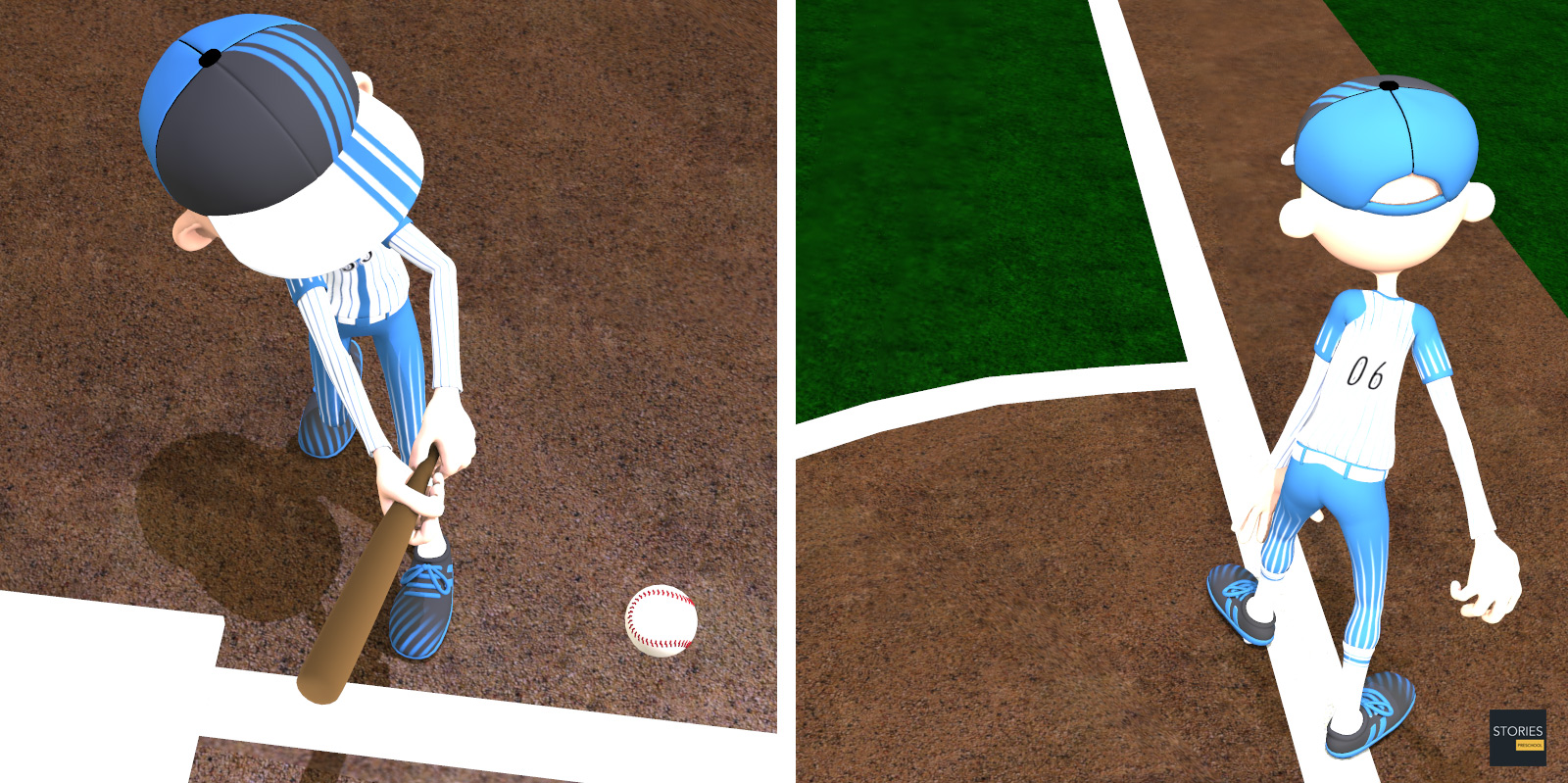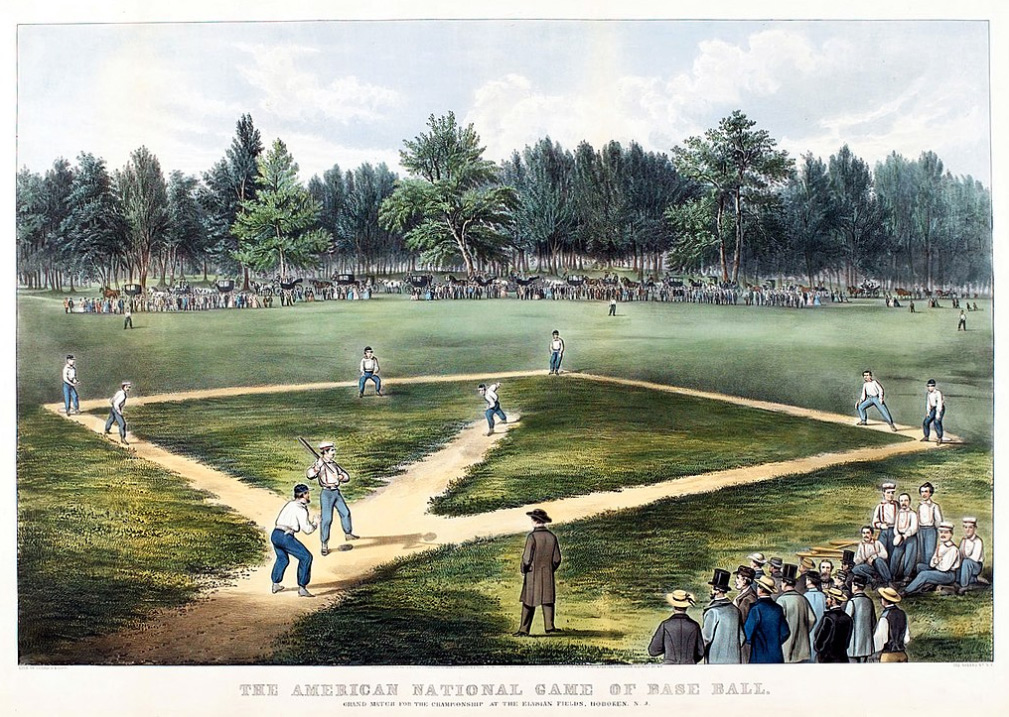Baseball

Baseball Home Run
In baseball, a home run (abbreviated HR, also "homer", "dinger", "bomb", "blast", "Big Dog" or "four-bagger") is scored when the ball is hit in such a way that the batter is able to circle the bases and reach home safely in one play without any errors being committed by the defensive team in the process. In modern baseball, the feat is typically achieved by hitting the ball over the outfield fence between the foul poles (or making contact with either foul pole) without first touching the ground, resulting in an automatic home run. There is also the "inside-the-park" home run, increasingly rare in modern baseball, where the batter reaches home safely while the baseball is in play on the field. When a home run is scored, the batter is also credited with a hit and a run scored, and an RBI for each runner that scores, including himself. Likewise, the pitcher is recorded as having given up a hit, and a run for each runner that scores including the batter.

Home runs are among the most popular aspects of baseball and, as a result, prolific home run hitters are usually the most popular among fans and consequently the highest paid by teams.
Out of the Park
The most common type of home run is hitting the ball over the outfield fence, or above a line on the outfield fence specifically designed to indicate a home run, in flight, in fair territory, without it being caught or deflected back by an outfielder into the playing field. This is sometimes called a home run "out of the ballpark", although that term is frequently used to indicate a blow that completely clears any outfield seating, as a home run is usually automatically assumed to have left the field of play unless otherwise indicated. A batted ball that hits the ground (in fair territory) and bounces out of play is not a home run, but an "automatic double" in most stadiums (colloquially called a ground rule double). It is also possible to hit a grand slam, which is a home run with a runner on each base.
A batted ball is also considered a home run if the ball touches any of the following while in flight, even if the ball subsequently rebounds back onto the playing field:
- Foul pole or attached screen
- Any fixed object where a particular ballpark's ground rules specifically state that a batted ball striking that object is a home run. This usually applies to objects such as scoreboards or architectural features which are beyond the outfield fence in fair territory, but are located such that it is difficult for an umpire to quickly judge their position in relation to the field from several hundred feet away.
- Glove, hat, or any equipment or apparel deliberately thrown by a fielder in an attempt to stop or deflect a fair ball that, in the umpires' judgment, would have otherwise been a home run
A home run accomplished in any of the above manners is an automatic home run. The ball is considered dead, and the batter and any preceding runners cannot be put out at any time while running the bases. However, if one or more runners fail to touch a base or one runner passes another before reaching home plate, that runner or runners can be called out on appeal, though in the case of not touching a base a runner can go back and touch it if doing so won't cause them to be passed by another preceding runner and they have not yet touched the next base (or home plate in the case of missing third base). This stipulation is in Approved Ruling (2) of Rule 7.10(b).
Inside-the-park Home Run
An inside-the-park home run occurs when a batter hits the ball into play and is able to circle the bases before the fielders can put him out. Unlike with an outside-the-park home run, the batter-runner and all preceding runners are liable to be put out by the defensive team at any time while running the bases. This can only happen if the ball does not leave the ball field.
In the early days of baseball, outfields were relatively much more spacious, reducing the likelihood of an over-the-fence home run, while increasing the likelihood of an inside-the-park home run, as a ball getting past an outfielder had more distance that it could roll before a fielder could track it down.

With outfields much less spacious and more uniformly designed than in the game's early days, inside-the-park home runs are now a rarity. They are usually the result of a ball being hit by a very fast runner, coupled with an outfielder either misjudging the flight of the ball (ex. diving and missing) or the ball taking an unexpected bounce. Either way, this sends the ball into open space in the outfield and thereby allows the batter-runner to circle the bases before the defensive team can put him out. The speed of the runner is crucial as even triples are relatively rare in most modern ballparks.
If any defensive play on an inside-the-park home run is labeled an error by the official scorer, a home run is not scored; instead, it is scored as a single, double, or triple, and the batter-runner and any applicable preceding runners are said to have taken all additional bases on error. All runs scored on such a play, however, still count.
Number of Runs Batted In
Home runs are often characterized by the number of runners on base at the time. A home run hit with the bases empty is seldom called a "one-run homer", but rather a solo home run, solo homer, or "solo shot". With one runner on base, two runs are scored (the baserunner and the batter) and thus the home run is often called a two-run homer or two-run shot. Similarly, a home run with two runners on base is a three-run homer or three-run shot.
The term "four-run homer" is seldom used; instead, it is nearly always called a "grand slam". Hitting a grand slam is the best possible result for the batter's turn at bat and the worst possible result for the pitcher and his team.
Grand Slam
A grand slam occurs when the bases are "loaded" (that is, there are base runners standing at first, second, and third base) and the batter hits a home run. According toThe Dickson Baseball Dictionary, the term originated in the card game of contract bridge. An inside-the-park grand slam is a grand slam that is also an inside-the-park home run, a home run without the ball leaving the field, and it is very rare, due to the relative rarity of loading the bases along with the significant rarity (nowadays) of inside-the-park home runs.
Specific Situation Home Runs
These types of home runs are characterized by the specific game situation in which they occur, and can theoretically occur on either an outside-the-park or inside-the-park home run.
Walk-off home run
A walk-off home run is a home run hit by the home team in the bottom of the ninth inning, any extra inning, or other scheduled final inning, which gives the home team the lead and thereby ends the game. Such a home run can also be called a "sudden death" or "sudden victory" home run. That usage has lessened as "walk-off home run" has gained favor.
A walk-off home run over the fence is an exception to baseball's one-run rule. Normally if the home team is tied or behind in the ninth or extra innings the game ends as soon as the home team scores enough runs to achieve a lead. If the home team has two outs in the inning, and the game is tied, the game will officially end either the moment the batter successfully reaches 1st base or the moment the runner touches home plate—whichever happens last. However, this is superseded by the "ground rule", which provides automatic doubles (when a ball-in-play hits the ground first then leaves the playing field) and home runs (when a ball-in-play leaves the playing field without ever touching the ground). In the latter case, all base runners including the batter are allowed to cross the plate.
Lead-off home run
A lead-off home run is a home run hit by the first batter of a team, the leadoff hitter of the first inning of the game.
Back-to-back
When two consecutive batters each hit a home run, this is described as back-to-back home runs. It is still considered back-to-back even if both batters hit their home runs off different pitchers. A third batter hitting a home run is commonly referred to as back-to-back-to-back.
Consecutive home runs by one batter
The occurrence of individuals hitting home runs in consecutive at-bats is not unusual, but three or more is rare. If a player hits three home runs in a game, it is termed a hat-trick (which is also used for a player getting three strikeouts in a game).
Home run cycle
An offshoot of hitting for the cycle, a "home run cycle" is where a player hits a solo, 2-run, 3-run, and grand slam home run all in one game. This is an extremely rare feat, as it requires the batter to not only hit four home runs in a game (which itself has only occurred 16 times in the Major Leagues), but also to hit those home runs with the specific number of runners already on base. Although it is a rare accomplishment, it is largely dependent on circumstances outside the player's control, such as his preceding teammates' ability to get on base, as well as the order in which he comes to bat in any particular inning.
Another variant of the home run cycle would be the "natural home run cycle", which would require a batter to hit a solo, 2-run, 3-run, and grand slam home run in that order.
SPORTS

RESOURCES
This article uses material from the Wikipedia articles "Baseball" and "Home run", which is released under the Creative Commons Attribution-Share-Alike License 3.0.
© Stories Preschool. All Rights Reserved.












